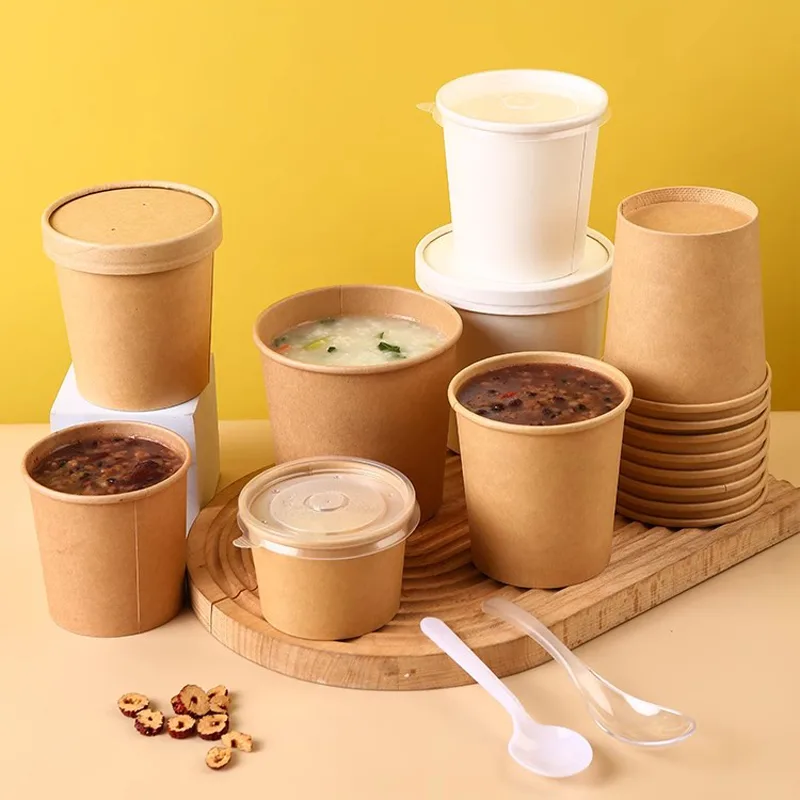Don’t Let Cheap Bowls Ruin Your Soup—Choose Certified Alternatives
Cheap paper soup bowls often leak, warp, and pollute. Learn how to choose certified compostable soup bowls that hold heat, resist leaks, and meet sustainability standards.

Introduction: When Packaging Fails, Everyone Notices
Soup is one of the most sensitive takeaway items. It’s hot, fluid, and packed with flavor—yet too often, it’s served in disposable soup bowls that are unfit for the task. Leaky seams, warped lids, and soggy paper linings don’t just spill soup—they spill customer satisfaction.
Whether you operate a cloud kitchen, quick-service restaurant, or catering brand, your soup bowl is part of the product. The wrong packaging will undermine food quality, damage your brand perception, and even contradict your sustainability claims.
In this blog, we uncover the problems with cheap soup packaging, highlight the science behind certified biodegradable soup bowls, and help you source paper soup bowls with lids that actually work—and break down cleanly after use.
The Real Cost of Low-Quality Soup Bowls
Cheap disposable soup bowls are often made from laminated paper or lightweight plastic that can't handle heat, moisture, or transport. While they may be inexpensive upfront, the hidden costs are significant:
-
Leakage & Spills: Resulting in messes, returns, or refunds
-
Brand Damage: Eco-conscious customers will notice non-compostable packaging
-
Compliance Risks: Increasing plastic bans make it risky to use non-certified packaging
-
Landfill Waste: Most PE-lined or PLA-lined bowls are not accepted in compost streams
According to a 2022 Packaging Sustainability Report by WRAP UK, 63% of disposable soup containers used by restaurants fail in performance during real-world delivery or storage—especially for hot broths.
Biodegradable vs. Compostable Soup Bowls: Know the Difference
Not all “green” packaging is created equal. Let’s clear up the definitions:
| Term | What it Actually Means |
|---|---|
| Biodegradable | Will break down eventually, but no guarantee on time or residue |
| Compostable | Breaks down in under 90 days, leaves no toxins, and becomes usable compost |
| Industrial Compostable | Requires high heat, controlled humidity (e.g., PLA bowls) |
| Home Compostable | Can decompose in backyard compost setups (e.g., sugarcane bagasse bowls) |
If your paper soup bowl has no recognized certification (like EN 13432 or ASTM D6400), it’s likely not compostable.
Certified Compostable Soup Bowls: What to Look For
High-quality compostable soup bowls are made from:
-
Bagasse (sugarcane fiber)
-
Bamboo pulp
-
Wheat straw fiber
-
Uncoated kraft paper (with water-based barrier)
These materials are:
-
Heat-resistant up to 120°C
-
Fully home or industrial compostable
-
Naturally resistant to oil and moisture
-
Sturdy and stackable for transport
Importantly, they must carry certifications:
| Certification | Region | What It Ensures |
|---|---|---|
| EN 13432 | Europe | Full degradation in industrial compost within 90 days |
| ASTM D6400 | US | Decomposition, eco-toxicity, and disintegration test |
| OK Compost | Global | Certification for industrial or home composting |
| BPI Certified | US/Canada | Widely recognized by compost processors |
Performance You Can Count On
Scientific testing confirms that certified paper soup bowls with lids outperform standard disposable options.
In a 2023 comparative trial by Food Packaging Institute, three types of bowls were tested with 95°C soup for 2 hours:
-
PE-lined paper bowl: warped and leaked
-
PLA-lined bowl: held but left microplastic residues in compost
-
Bagasse fiber bowl: no leakage, maintained integrity, fully composted in 70 days
Conclusion: The best disposable bowls for hot soup are certified compostable bowls made from natural fibers—not plastic-lined imposters.
Lids Matter, Too
Don’t ignore the lid.
A certified compostable soup bowl paired with a plastic lid ruins the composting potential. Always opt for:
-
Fiber-based lids (bagasse or bamboo)
-
Water-based barrier paper lids
-
Compostable bio-PP or CPLA lids (if fiber isn’t feasible)
Match bowl + lid = full compostability.
Case Study: Soup Chain Revamp
A mid-size European meal delivery brand switched from low-cost PE-lined containers to compostable soup bowls in Q1 2023.
Results after 6 months:
-
98% reduction in packaging complaints
-
27% increase in customer satisfaction for “eco packaging”
-
Qualified for green restaurant certification
-
Gained partnerships with waste processors accepting certified packaging
-
Saved money in plastic tax penalties
Where to Buy: Certified Bulk Suppliers
Recommended: Xiamen Bioleaderpack Co., Ltd.
Why Bioleaderpack?
-
Certified under EN 13432, ASTM D6400, OK Compost, BPI
-
Offers paper soup bowls with lids in all popular sizes (8oz–32oz)
-
OEM/ODM branding with leak-proof, high-heat performance
-
Ships globally to the U.S., Europe, Australia, Southeast Asia
-
Trusted by hundreds of QSR chains, delivery brands, and sustainable events

FAQ
1. What’s the difference between biodegradable and compostable soup bowls?
Biodegradable bowls can degrade eventually, but compostable bowls break down in 90 days or less and are certified non-toxic.
2. Are paper soup bowls really eco-friendly?
Only if they are plastic-free and certified. Most cheap paper soup bowls contain PE or PLA linings that prevent composting or recycling.
3. What are the best disposable bowls for hot soup?
The best are bagasse or bamboo fiber compostable soup bowls—durable, leak-proof, and heat-resistant up to 120°C.
4. Do compostable soup bowls hold hot liquids?
Yes. Certified biodegradable soup bowls are engineered to hold soups, curries, and broths without leaking or warping.
5. Where can I buy compostable takeaway soup bowls in bulk?
Suppliers like Xiamen Bioleaderpack offer certified, high-performance disposable soup bowls for wholesale, OEM branding, and export.
Final Thoughts: Your Packaging Is Your Brand
It’s no longer enough to focus on the contents of your bowl. Your customers care just as much about the container—how it performs and how it affects the planet.
Don’t let a cheap, plastic-lined bowl ruin your customer’s soup, your compost stream, or your reputation.
✅ Choose certified
✅ Choose compostable
✅ Choose a supplier that can prove both
What's Your Reaction?
















.jpg)
.jpg)


